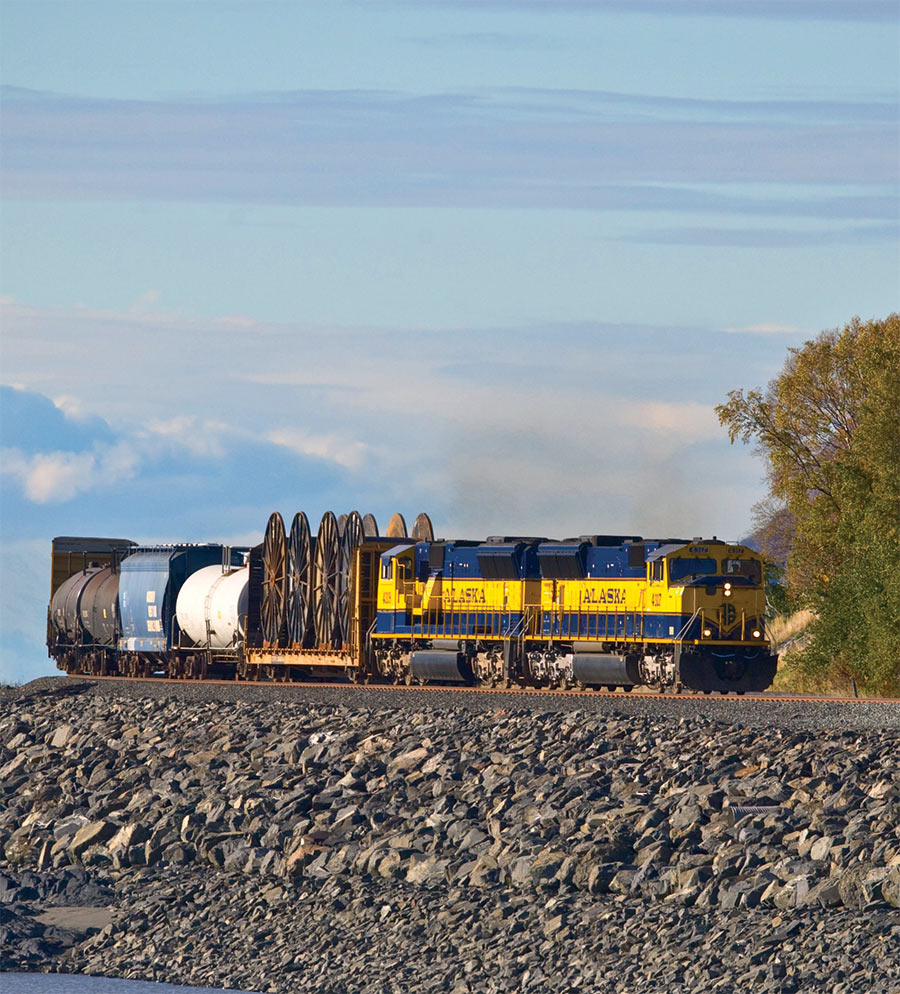
s the state’s only freight rail provider, the Alaska Railroad Corporation is an integral part of Alaska’s economic landscape according to Dale Wade, Vice President of Marketing and Customer Service. As such, he says it’s important to understand customer needs and their broader goals.
“The reality is, Alaska lives on project work—we don’t produce automotive or computer parts or anything like that,” Wade says. “Being a resource-intensive environment, we live and die based on big projects. The railroad plays a big role in handling heavy equipment, steel products, cement, a number of raw commodities, and raw ingredients that make up construction work.”
The Alaska Railroad typically sees its first influx of tourists in the spring—but COVID-19 stopped business in its tracks. In a typical year, the Railroad takes more than 500,000 passengers on stunning tours of Alaska, but 2020 is no typical year.
Wade says the Alaska Railroad has suffered due to the pandemic, like most other businesses in the state.
“We came into 2020 in good shape,” Wade says. “The first quarter was looking strong, and then it really came to a screeching halt. Along with the passenger service—which was more of a challenge to handle and adjust to—the freight business slowed down slower and accelerated slower.”
While ridership suffered severely, Wade says other lines of revenue like freight and real estate helped ease the gap. He hopes the railroad will see passenger service return, even slowly, in 2021.
“We’re blessed with having a three- or four-legged milk stool—it gives us stability,” Wade says. “The largest of our business is freight. Freight was relatively stable last year. It took a dip when the oil fields shut down and the price of oil plummeted and all of that… 2019 was a really strong year in a number of regards to the company.”
The Alaska Railroad is still selling tickets for passenger travel, although with some adjustments related to COVID-19. Riders should expect to wear face coverings while on the train, although they can be removed for eating and drinking. Passenger cars are capped at 50% capacity to allow for social distancing and hand sanitizer is stationed within each car.
In addition, a dedicated custodial porter sanitizes all surfaces on the train every 30 minutes, including seating areas and bathrooms. Passenger trains also undergo a full sanitization every night.
“We bring their railcars to Alaska on our barges. They also carry a lot of our containers and trailers—they do that for the entire industry,” Hicks says. “We have a pretty long relationship with them. They pretty much operate every day of the year, regardless of weather conditions, just because they are providing a service that has to be done every day, in all kinds of inclement weather. It takes a lot in Alaska to keep the tracks clear and the tracks maintained. When it comes to the actual construction side, they are moving aggregate materials in the summertime… those are all time-sensitive things, outside of the passengers who travel on the railroad.”
“Generally speaking, the thing that surprised me the most was, as we work with our contractors and outside vendors to get work done, none of that ever really stopped,” Lindamood says. “We had isolated cases where this was delayed or that was delayed—largely on the supplier side—but when it came to getting the work done, we never had any issues with contractors saying, ‘Well, everybody’s got COVID this week.’”
Since the pandemic hit Alaska, the vast majority of the railroad’s employees—from marketing to HR—are working remotely. Lindamood says those plans aren’t changing anytime soon.

Cale Green
“On the positive side, less trains equates to greater work windows for the Maintenance of Way and Engineering groups to get important projects done,” Wade says. “Make no mistake, we love running trains. Nevertheless, this was a good summer to get important construction and track maintenance work done, and we took advantage of that opportunity.”
Alaska Railroad Corporation has been an AGC member since 2003. Lindamood says the Railroad’s membership with the organization has created an open line of communication with the contracting community.
“We do rely a lot on AGC and its members to help us with our capital program,” Lindamood says. “We have a lot of work, we have got some very talented, very capable people on staff, but as capital work ebbs and flows, we turn to AGC members every year to help us get some of that work done.”
Looking to the future, Lindamood says the Alaska Railroad has some larger projects in the future, including significant bridge replacements. Some grant-funded bridges will begin construction in 2021.